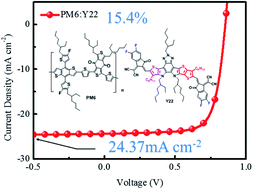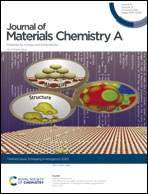An asymmetric small molecule acceptor for organic solar cells with a short circuit current density over 24 mA cm−2†
Abstract
In comparison with symmetric small molecule acceptors (SMAs), their asymmetric counterparts have received much less attention. Organic solar cells (OSCs) based on asymmetric non-fullerene SMAs previously reported show relatively low power conversion efficiency (PCE < 15%) and lower short circuit current densities (Jsc < 20 mA cm−2), although they exhibit a larger dipole moment and stronger intermolecular interactions. Here we report a new asymmetric A–D1A′D2–A type SMA, namely Y22, containing an asymmetric hexacyclic fused donor–acceptor–donor (DA′D) type central framework and end-capped with two electron-deficient 2-(5,6-difluoro-3-oxo-2,3-dihydro-1H-inden-1-ylidene)malononitrile moieties. Y22 shows good solubility and a broad near-infrared absorption. The effects of the asymmetric structure on the physicochemical and photovoltaic performance were systematically investigated. Y22-based OSCs were fabricated by using PM6, QX2 and J71 as polymer donors, all exhibiting high PCEs over 10%. Notably, the optimal PM6:Y22-based device shows a high PCE of 15.4% and a high Jsc of 24.37 mA cm−2, which is among the best values reported for asymmetric SMA based OSCs, attributed to the fine nanofiber morphology after thermal annealing and solvent addition. This work demonstrates that the asymmetric fused structure with an electron-deficient-core is a promising building block to build high performance SMAs towards efficient photovoltaic applications.

- This article is part of the themed collection: Journal of Materials Chemistry A Emerging Investigators


 Please wait while we load your content...
Please wait while we load your content...